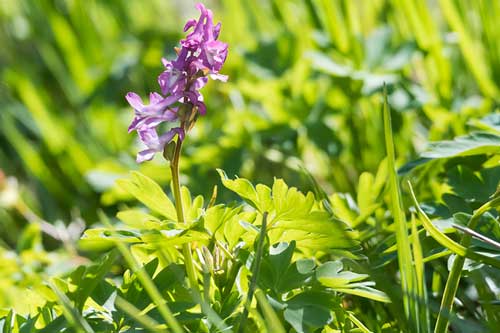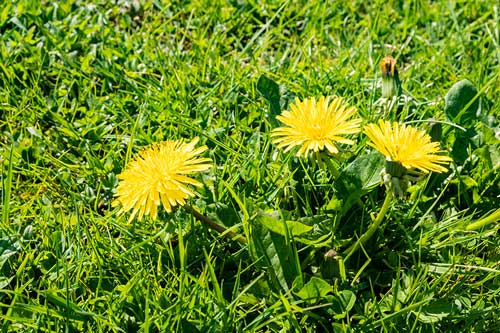As winter fades and temperatures begin to rise, lawns across the country start showing signs of life. Unfortunately, that also means weeds are making an appearance. Early spring lawn weeds can be a major headache for homeowners trying to maintain a thick, green lawn. These unwelcome invaders compete with grass for nutrients, water, and sunlight, often spreading before you even realize they’re there.
Knowing which weeds to watch for—and how to control them—can make all the difference in keeping your lawn healthy. In this guide, we’ll break down the most common early spring weeds and share expert tips for best practices for lawn weed prevention to help you get ahead of the problem.
Common Early Spring Weeds to Watch For
1. Henbit (Lamium amplexicaule)

Henbit is one of the first weeds to emerge in early spring, quickly spreading in thin or bare lawn areas. Its purple, tubular flowers and square stems make it easy to identify.
Henbit is one of the first weeds to emerge in early spring. Recognizable by its square stems and purple, tubular flowers, henbit thrives in thin or bare lawn areas. It spreads quickly and can become dense if left unchecked.
How to Control It:
Applying a pre-emergent herbicide in late fall or early spring is the best way to prevent henbit from sprouting. If it has already emerged, a post-emergent broadleaf herbicide can help eliminate it. Keeping your lawn thick and healthy also discourages its growth.
2. Chickweed (Stellaria media)
Common chickweed is a low-growing, fast-spreading weed with small white flowers and light green leaves. It thrives in moist, shady areas and can form dense mats that choke out grass.
How to Control It:
Mulching garden beds and maintaining a well-drained lawn can reduce chickweed infestations. Applying a pre-emergent herbicide in early spring can prevent new growth. For established chickweed, hand-pulling or using a selective herbicide works best.
3. Purple Deadnettle (Lamium purpureum)
Often confused with henbit, purple deadnettle has similar square stems but with triangular, fuzzy leaves that turn purple as they mature. It flourishes in cool, damp conditions and spreads aggressively.
How to Control It:
A well-maintained lawn with proper fertilization and aeration discourages purple deadnettle. Post-emergent herbicides targeting broadleaf weeds can help control existing growth.
4. Dandelion (Taraxacum officinale)

Dandelions are a common spring weed, known for their bright yellow flowers that quickly transform into fluffy seed heads. Each plant can produce thousands of seeds, allowing them to spread rapidly across lawns if left uncontrolled.
A familiar sight in spring, dandelions have bright yellow flowers that turn into fluffy seed heads. They reproduce rapidly, with each plant capable of producing thousands of seeds.
How to Control It:
Hand-pulling dandelions can be effective if done before they seed, but their deep taproots make them difficult to remove completely. A broadleaf herbicide can help control widespread infestations. Applying a pre-emergent in early spring prevents new dandelions from taking root.
5. Annual Bluegrass (Poa annua)
This grassy weed is often mistaken for desirable turfgrass. It grows in clumps, has a pale green color, and produces small seed heads. Unlike other weeds on this list, annual bluegrass prefers well-manicured lawns and can be tricky to eliminate.
How to Control It:
Using a pre-emergent herbicide in late summer or early fall helps prevent annual bluegrass from germinating. Keeping your lawn properly fertilized and mowed at the correct height also reduces its spread.
Preventing Early Spring Weeds
Stopping weeds before they start is always easier than dealing with a full-blown invasion. Here are some key steps to prevent weeds from taking over your lawn this spring:
Apply Pre-Emergent Herbicides
Pre-emergents create a barrier that stops weed seeds from sprouting. The best time to apply them is late winter to early spring, before soil temperatures reach 55°F.
Maintain a Thick, Healthy Lawn
A dense lawn naturally suppresses weed growth by blocking sunlight and crowding out weed seedlings. Regular fertilization, aeration, and overseeding help keep your turf strong.
Mow at the Right Height
Cutting your grass too short weakens it, allowing weeds to take over. Cool-season grasses like fescue and bluegrass should be mowed at 3 to 4 inches to shade out weed seeds.
Water Wisely
Overwatering creates ideal conditions for weeds like chickweed and annual bluegrass. Water deeply but infrequently to encourage deep root growth in your lawn.
How to Eliminate Established Weeds
If weeds have already taken hold, quick action is necessary to prevent them from spreading further. Here’s how to effectively remove them:
Hand-Pulling & Spot Treatment
For small weed patches, hand-pulling is a simple and effective method. Be sure to remove the entire root system. Spot-treating with a targeted herbicide can also help eliminate stubborn weeds without harming your grass.
Post-Emergent Herbicides
If weeds are widespread, a post-emergent herbicide designed for broadleaf or grassy weeds may be necessary. Always follow label instructions and apply when temperatures are between 60-85°F for best results.
Integrated Weed Management Strategies
For long-term success, consider adopting an integrated weed management strategy that combines chemical, cultural, and mechanical control methods. This approach minimizes the need for herbicides while keeping your lawn healthy and resilient.
Take Action for a Weed-Free Lawn This Spring
Early spring weeds can be frustrating, but with the right prevention and control strategies, you can keep them at bay. By applying pre-emergent herbicides, maintaining a strong lawn, and addressing weed problems early, you’ll set your yard up for a healthy growing season.
If weeds are already taking over your lawn, don’t wait—professional lawn care experts can help. Consider reaching out to a local lawn care provider to schedule a consultation and get your lawn back on track!
Let Us Help You With Your Lawn Care Needs
As spring approaches, now is the perfect time to schedule a consultation with our team. Let Aspen Lawn & Pest Control help you prepare your lawn for the growing season, ensuring it stays lush, healthy, and weed-free. Contact us today and schedule your Free Estimate!


Socials